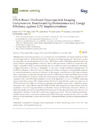Identificador persistente para citar o vincular este elemento:
https://accedacris.ulpgc.es/jspui/handle/10553/76421
| Título: | Fpga-based on-board hyperspectral imaging compression: Benchmarking performance and energy efficiency against gpu implementations | Autores/as: | Caba, Julián Díaz, María Barba, Jesús Guerra Yanez, Raúl de la Torre, Jose A. López, Sebastián |
Clasificación UNESCO: | 220990 Tratamiento digital. Imágenes | Palabras clave: | FPGA GPU Hyperspectral Imaging Lossy Compression On-Board Processing, et al. |
Fecha de publicación: | 2020 | Publicación seriada: | Remote Sensing | Resumen: | Remote-sensing platforms, such as Unmanned Aerial Vehicles, are characterized by limited power budget and low-bandwidth downlinks. Therefore, handling hyperspectral data in this context can jeopardize the operational time of the system. FPGAs have been traditionally regarded as the most power-efficient computing platforms. However, there is little experimental evidence to support this claim, which is especially critical since the actual behavior of the solutions based on reconfigurable technology is highly dependent on the type of application. In this work, a highly optimized implementation of an FPGA accelerator of the novel HyperLCA algorithm has been developed and thoughtfully analyzed in terms of performance and power efficiency. In this regard, a modification of the aforementioned lossy compression solution has also been proposed to be efficiently executed into FPGA devices using fixed-point arithmetic. Single and multi-core versions of the reconfigurable computing platforms are compared with three GPU-based implementations of the algorithm on as many NVIDIA computing boards: Jetson Nano, Jetson TX2 and Jetson Xavier NX. Results show that the single-core version of our FPGA-based solution fulfils the real-time requirements of a real-life hyperspectral application using a mid-range Xilinx Zynq-7000 SoC chip (XC7Z020-CLG484). Performance levels of the custom hardware accelerator are above the figures obtained by the Jetson Nano and TX2 boards, and power efficiency is higher for smaller sizes of the image block to be processed. To close the performance gap between our proposal and the Jetson Xavier NX, a multi-core version is proposed. The results demonstrate that a solution based on the use of various instances of the FPGA hardware compressor core achieves similar levels of performance than the state-of-the-art GPU, with better efficiency in terms of processed frames by watt. | URI: | https://accedacris.ulpgc.es/handle/10553/76421 | ISSN: | 2072-4292 | DOI: | 10.3390/rs12223741 | Fuente: | Remote Sensing [EISSN 2072-4292], v. 12 (22), 3741, p. 1-37, (Noviembre 2020) |
| Colección: | Artículos |
Citas SCOPUSTM
25
actualizado el 08-jun-2025
Citas de WEB OF SCIENCETM
Citations
21
actualizado el 08-jun-2025
Visitas
109
actualizado el 16-sep-2023
Descargas
98
actualizado el 16-sep-2023
Google ScholarTM
Verifica
Altmetric
Comparte
Exporta metadatos
Los elementos en ULPGC accedaCRIS están protegidos por derechos de autor con todos los derechos reservados, a menos que se indique lo contrario.
